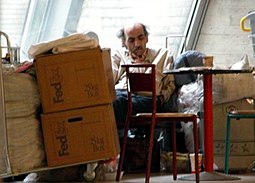Shoichi Yokoi
Shōichi Yokoi (横井 庄一 Yokoi Shōichi, March 31, 1915 – September 22, 1997) was a Japanese sergeant in the Imperial Japanese Army (IJA) during the Second World War. He was among the last three Japanese holdouts to be found after the end of hostilities in 1945, discovered in the jungles of Guam on 24 January 1972, almost 28 years after U.S. forces had regained control of the island in 1944.
Early life
Yokoi was born in Saori, Aichi Prefecture. He was an apprentice tailor when he was conscripted in 1941
War years and post-war survival
Initially, Yokoi served with the 29th Infantry Division in Manchukuo. In 1943, he was transferred to the 38th Regiment in the Mariana Islands and arrived on Guam in February 1943. When American forces captured the island in the 1944 Battle of Guam, Yokoi went into hiding with nine other Japanese soldiers. Seven of the original ten eventually moved away and only three remained in the region. These men separated but visited each other until about 1964, when the other two died in a flood. The last eight years Yokoi lived alone. Yokoi survived by hunting, primarily at night. He used native plants to make clothes, bedding, and storage implements, which he carefully hid in his cave.
Capture
On the evening of 24 January 1972, Yokoi was discovered in the jungle[by Jesus Dueñas and Manuel De Gracia, two local men checking their shrimp traps along a small river on Talofofo. They had assumed Yokoi was a villager from Talofofo, but he thought his life was in danger and attacked them. They managed to subdue him and carried him out of the jungle with minor bruising.
"It is with much embarrassment that I return," he said upon his return to Japan. The remark quickly became a popular saying in Japan.
Despite hiding for twenty-eight years in an underground jungle cave, he had known since 1952 that World War II had ended. He feared coming out of hiding, explaining, "We Japanese soldiers were told to prefer death to the disgrace of getting captured alive."
Yokoi was the antepenultimate Japanese soldier to surrender after the war, preceding Second Lieutenant Hiroo Onoda (relieved from duty by his former commanding officer on 9 March 1974) and Private Teruo Nakamura (arrested 18 December 1974).
Later life
After a whirlwind media tour of Japan, he married and settled down in rural Aichi Prefecture.
Yokoi became a popular television personality and an advocate of austere living.
He was featured in a 1977 documentary film called Yokoi and His Twenty-Eight Years of Secret Life on Guam.
He eventually received the equivalent of US$300 in back pay, and a small pension.
Although he never met Emperor Hirohito, while visiting the grounds of the Imperial Palace, Yokoi said, "Your Majesties, I have returned home ... I deeply regret that I could not serve you well. The world has certainly changed, but my determination to serve you will never change."
Yokoi died in 1997 of a heart attack at the age of 82, and was buried at a Nagoya cemetery, under a gravestone that had originally been commissioned by his mother in 1955, after Yokoi had been officially declared dead.
Museum
The Shoichi Yokoi Memorial Hall opened in 2006 in Nakagawa-ku, Nagoya. Admission is free.





 A young baby was born in one of the most discussed about countries here at Unusual people. you guessed it India. Lakshmi Tatma is now two years old and has taken her first steps after a life saving operation. The young girl was worshipped in her country and the ocals thought she was like a goddess because of her unusual medical condition.
A young baby was born in one of the most discussed about countries here at Unusual people. you guessed it India. Lakshmi Tatma is now two years old and has taken her first steps after a life saving operation. The young girl was worshipped in her country and the ocals thought she was like a goddess because of her unusual medical condition.
